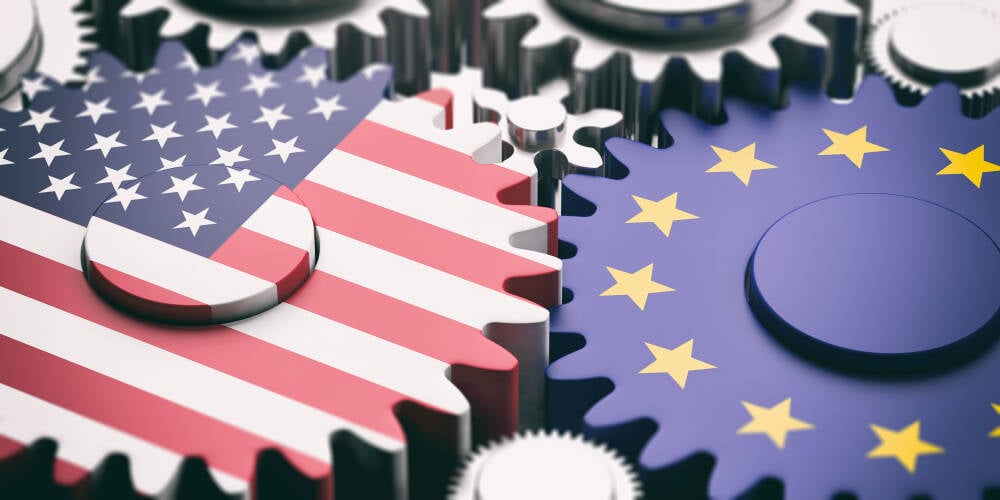
AI, 6G, semiconductor supply chains and critical minerals were all discussed at the latest EU-US Trade and Technology Council (TTC), amid concerns that a victory for Republican candidate Donald Trump in this year’s election would put an end to such cooperation.
The sixth ministerial meeting of the TTC in Belgium aimed at thrashing out a number of key issues between the two regions, amidst a backdrop of “significant geopolitical developments and challenges”, according to a joint statement regarding the talks.
Previous meetings had seen agreement to coordinate efforts on semiconductor supply chain resilience, such as an early warning mechanism to identify potential disruptions, and a transparency mechanism to share details on support each was providing to its own chipmaking sector.
The two said they intend to extend these arrangements for three years to further collaboration and “establish synergies” between the investments now being made under the EU Chips Act and the US CHIPS Act.
Shared concerns also include “non-market economic policies” and “practices that may lead to distortionary effects or excessive dependencies on mature node (“legacy”) semiconductors. This is likely a reference to China, which is ramping up output of mature production processes (typically meaning 28nm or above), leading to fears it could soon flood the market with these chips.
US Secretary of Commerce Gina Raimondo said at a press conference following the meeting that there had been “a very robust discussion” about using the TTC in protecting shared interests in national security and economic security, including China.
“So in that respect, I think the TTC has shown itself to be effective and it’s an area of prioritization as the TTC moves forward,” she added.
No concrete action appears to have been decided, however. Brussels and Washington merely agreed to convene further government-to-government discussions with “likeminded countries” on this topic, to share market intelligence and consult each other on planned actions. Joint measures to address distortionary effects on the global supply chain have not been ruled out, however.
The EU and US do plan to cooperate on research to identify alternatives for some of the harsh chemicals used in semiconductor manufacturing, an issue that chip giant Intel discussed at its Sustainability Summit last month.
In particular, the two will look into perfluorinated and polyfluorinated substances (PFAS), and said they are exploring the use of techniques such as AI and digital twins to accelerate the discovery of replacements for these.
On AI itself, the two parties reaffirm their commitment to developing a “risk-based approach” to advancing safe, secure, and trustworthy AI technologies. Leaders from the European AI Office and the United States AI Safety Institute briefed one another on their respective approaches and mandates, according to the joint statement.
When asked about the recent US-UK agreement on AI safety, Raimondo said that the EU and US were committed to a dialog to deepen collaboration, while EC Executive Vice-President Margrethe Vestager said that the two were now much closer together than before on AI, and “we have an agreed approach for the very first time”.
It’s a similar tale when it comes to 6G, with the two parties claiming to have “shared principles” for the research and development of 6G wireless communication systems, and the need to by work together on technologies for critical digital infrastructure that reflect shared values.
The joint statement says that the EU and US have adopted a joint “6G vision” that focuses on technology challenges and research collaboration, but this appears to have been informed by an earlier joint statement on 6G issued by ten nations that include the UK, Japan and Korea as well as some EU countries and the US.
Another area of concern is critical minerals, especially with China’s move to restrict the export of elements used in semiconductors such as gallium and germanium last year, for which the country is a major source.
Again the EU and US promised to keep up close collaboration on such matters, and welcomed the launch of the Mineral Security Partnership (MSP) Forum, which both blocs are involved in. The pair also stated they are advancing negotiations toward a Critical Minerals Agreement.
However, a shadow hangs over the future of the TTC itself, with fears that if Trump were to return to the White House later this year, his administration would likely terminate the cooperation in favor of more protectionist policies, such as previously installed US tariffs on EU steel and aluminium.
This would, ironically, make it harder to maintain a united position against China’s growing dominance. For example, Washington is currently pressing the Netherlands to force photolithography giant ASML not to honor maintenance contracts with Chinese chipmakers, and there is already some pushback on this because of the importance of the company to the Dutch economy.
According to Euractiv, the European Commission is trying to allay fears over the future of the TTC, quoting an EU official saying “We believe that the EU-US transatlantic relationship is there to stay and has a lot of value added on both sides,” and that “Regardless of whoever is going to be next year in the White House or in the Berlaymont [EC building], this strength has to continue to be nurtured and developed.”
However, the official conceded that the Commission was setting up an internal process to prepare for all possible outcomes from the US presidential elections. ®
- SEO Powered Content & PR Distribution. Get Amplified Today.
- PlatoData.Network Vertical Generative Ai. Empower Yourself. Access Here.
- PlatoAiStream. Web3 Intelligence. Knowledge Amplified. Access Here.
- PlatoESG. Carbon, CleanTech, Energy, Environment, Solar, Waste Management. Access Here.
- PlatoHealth. Biotech and Clinical Trials Intelligence. Access Here.
- Source: https://go.theregister.com/feed/www.theregister.com/2024/04/08/ttc_future_in_balance/



